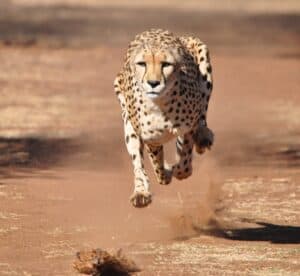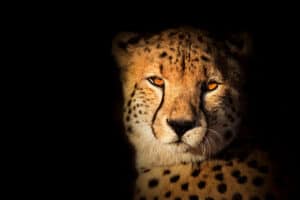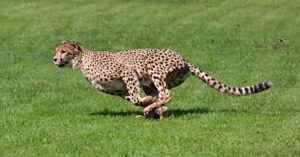The cheetah is most well-known as the fastest land animal on the planet. This extraordinary speed is the cheetah’s primary weapon in hunting its prey. Many of the cheetah’s preferred prey animals are speedsters in their own right, such as gazelles, antelopes, wildebeests, zebras, and hares. However, the cheetah is genetically designed to run.
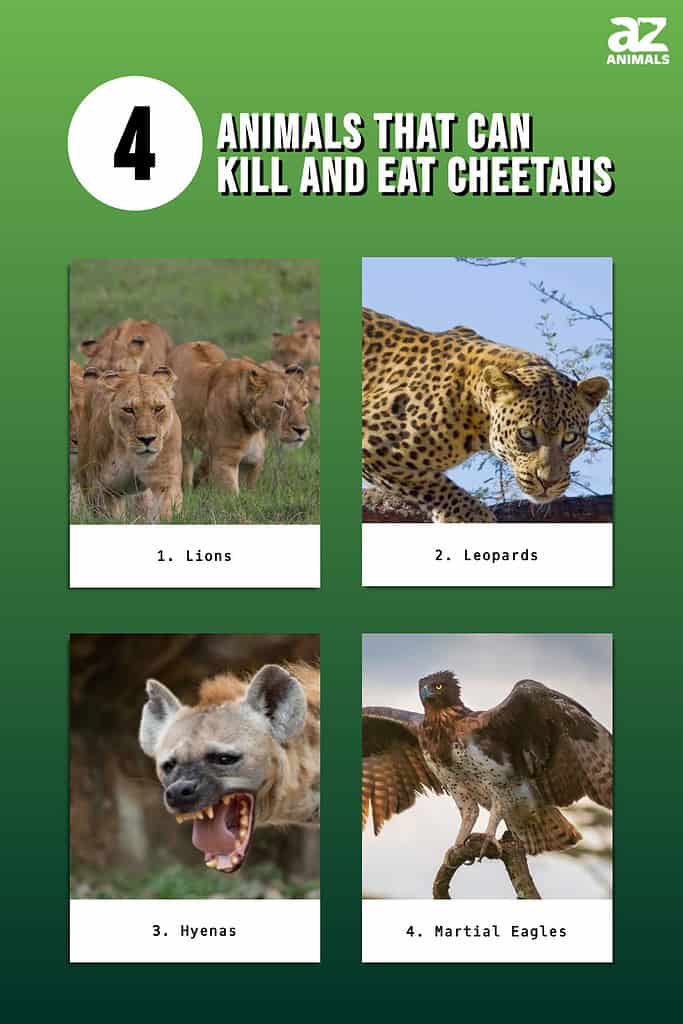
The cat’s small head and long legs aid in the cheetah’s aerodynamic body structure. Its flexible spine also allows the cat to turn and change direction at full speed. The cheetah is sleek and slender, with a light body weight allowing it to reach 60 miles per hour in just three seconds. In fact, the cheetah is the smallest of the big cats. Its size, while superb for high-speed chases, also makes it vulnerable. We typically view the cheetah as a predator and not a prey animal, but a few large carnivores will actually target cheetahs as prey.
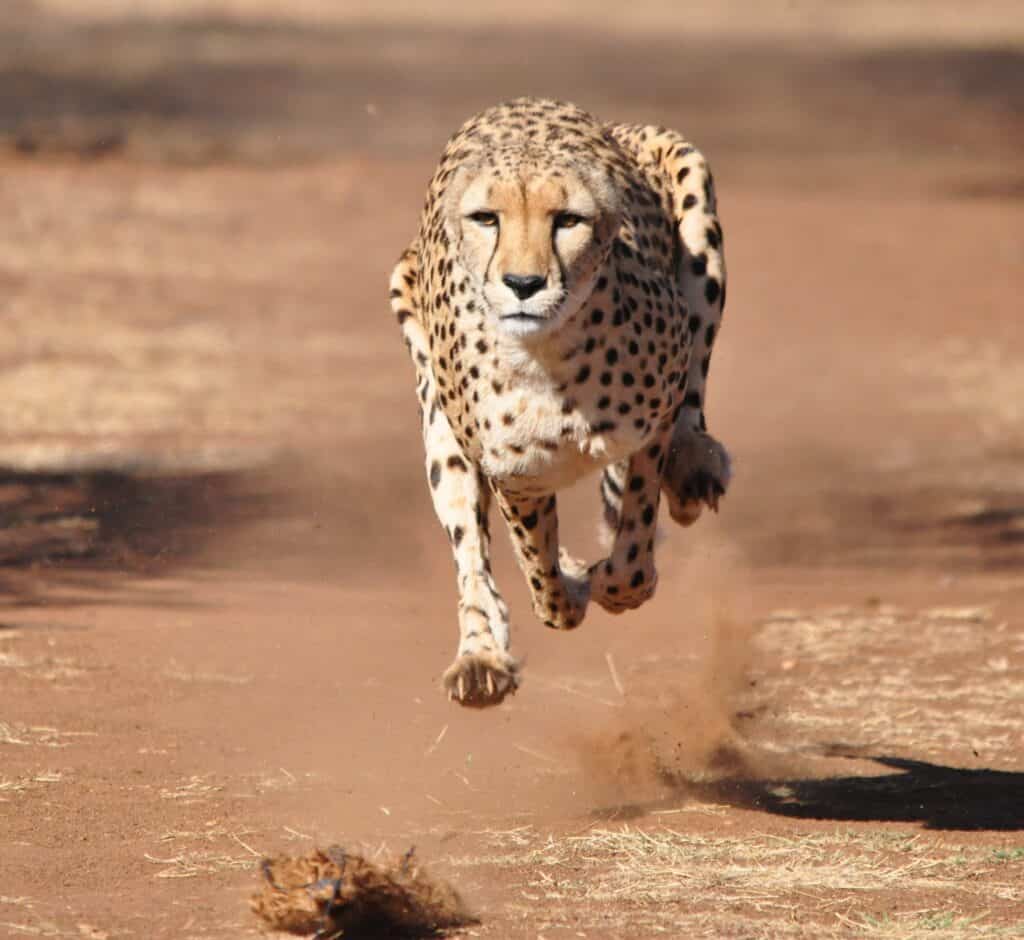
Cheetahs are built for speed!
©Marcel Brekelmans/Shutterstock.com
What Eats Cheetahs?
1. Lions
Lions are the apex predators of the African savanna. While their preferred prey includes zebras, buffalo, wildebeests, and warthogs, lions are opportunistic and will prey on a wide variety of other animals, including the occasional cheetah.
Cheetah cubs are an easy meal for a lion. Some estimate only about 5-15% of cheetah cubs survive to adulthood in the Serengeti plains of East Africa. One major reason for the low survival rate is lion predation.
It’s not just cheetah cubs, though. While rare, lions have been known to prey on mature cheetahs. A large male cheetah can weigh 130-140 pounds. Meanwhile, the lion is a member of Africa’s Big Five. A mature female lion can weigh upwards of 400 pounds, while an adult male can weigh 550 pounds.
The small build of a cheetah is simply no match for a lion. Cheetahs are built for speed, not for conflict. Their speed means that fatal lion attacks are a rarity. A cheetah can reach a top speed of 70 miles per hour, while a lion’s maximum speed is closer to 35 miles per hour.
While cheetahs rely on speed, lions rely on stealth. Lions also hunt in groups. If a lion pride can hem in a cheetah, the cheetah stands little chance of survival.
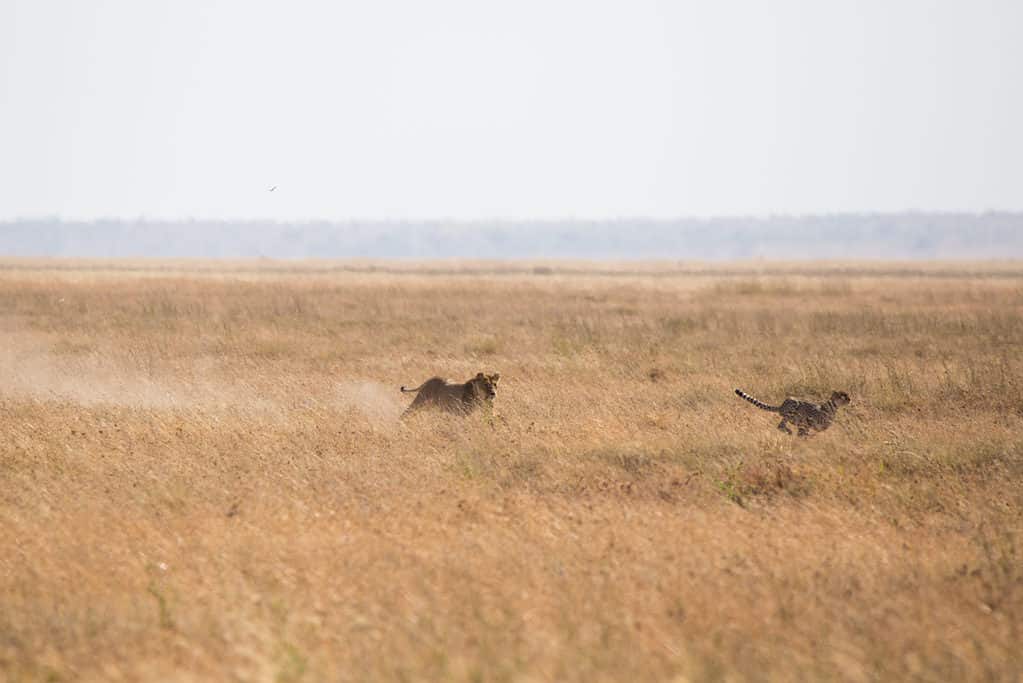
Lions typically hunt cheetah cubs but have been known to prey on mature cheetahs.
©iStock.com/Janne Niiranen
2. Leopards
Cheetahs are taller at the shoulder and stand higher overall than leopards. Leopards are actually the shortest of the big cats. But, while the cheetah is taller, the leopard is significantly stronger.
When a leopard makes a large kill, it will often drag the carcass up a tree to protect it from other predators. Leopards have been known to haul a kill 2-3 times their own body weight up to the treetops. Pound for pound, the leopard is the strongest cat in Africa.
This brute strength is no match for the leopard’s preferred prey, such as impalas, gazelles, bushbucks, and common duikers. However, the leopard’s brawn also allows it to take down smaller carnivores, such as foxes, genets, jackals, and even cheetahs.
Leopards are opportunists that will take whatever meal presents itself. Researchers have documented more than 100 different species that have been included on the leopard’s menu. While cheetahs aren’t at the top of the list, a leopard will certainly not turn down an opportunity to prey on one.
Again, the cheetah’s speed is its greatest defense. A leopard’s top speed is similar to that of a lion, so if it comes down to a simple footrace, the cheetah will win easily.
Leopards, however, are among the world’s stealthiest hunters. The element of surprise is critical, as many prey animals are faster than leopards and also have far greater stamina. The leopard’s rosette-shaped spots provide outstanding camouflage. This allows the leopard to either stalk its prey or wait in ambush.
Cheetah cubs are especially vulnerable to leopard predation, but, while rare, mature cheetahs can also become prey for these super-stealthy cats.
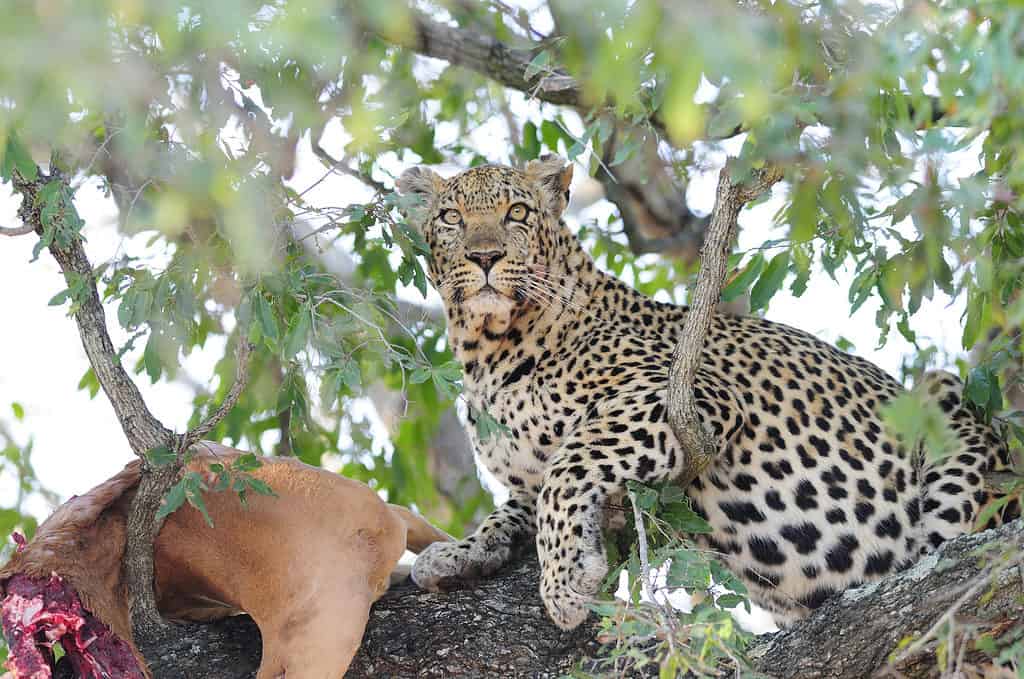
Leopards are powerful enough to haul large kills up to the treetops.
©iStock.com/RichLindie
3. Hyenas
At a glance, it may not appear that a hyena would be much of a threat to a cheetah. However, as is often the case in the animal kingdom, looks can be deceiving.
Strong and Fast Predators
A hyena’s bite is devastatingly strong. A spotted hyena packs a bite force of 1,100 PSI. That is more than twice the bite strength of a lion! The bite of a hyena is comparable to that of a polar bear, which has a bite force of 1,200 PSI.
Hyenas also hunt in groups. A single hyena would stand little chance of catching a cheetah. Hyenas feature similar speeds as lions and leopards. In a group, however, the odds can shift. It is still rare for a group of hyenas to take down a mature cheetah, but it has been known to happen.
A fully-grown cheetah is not at the top of the hyena’s menu simply due to the amount of effort and energy needed for the hunt. Hyenas are occasional scavengers. If the opportunity presents itself, hyenas will follow behind larger predators and eat the scraps of a kill, bones and all.
Opportunistic and Effective Hunters
Primarily, though, hyenas are opportunistic hunters. If there is an easy meal to be had, hyenas will grab it. Cheetah cubs can become targets. Let unattended, these cubs make for quick and nearly effortless hyena fare.
When hunting larger animals, hyenas band together and have an impressive track record. A hyena clan’s hunting success rate can sometimes be as high as almost 75%.
A successful hyena hunt is usually a combination of persistence and intelligence. These carnivores have a reputation as being rather unintelligent animals. They are often portrayed as dim-witted creatures in stories and movies. Who can forget Scar, the evil lion in Disney’s The Lion King? Seeing the antics of his hyena henchmen, Scar said, “I’m surrounded by idiots.”
In reality, hyenas are anything but idiots. They are highly intelligent creatures and are significantly smarter than many other carnivores who share their hunting grounds, including lions. Some researchers believe that the hyena’s intelligence could even be comparable to that of primates.
Using this intelligence, along with good old-fashioned patience and persistence, hyenas can take down large prey animals such as wildebeests, antelopes, and, on rare occasions, even cheetahs.
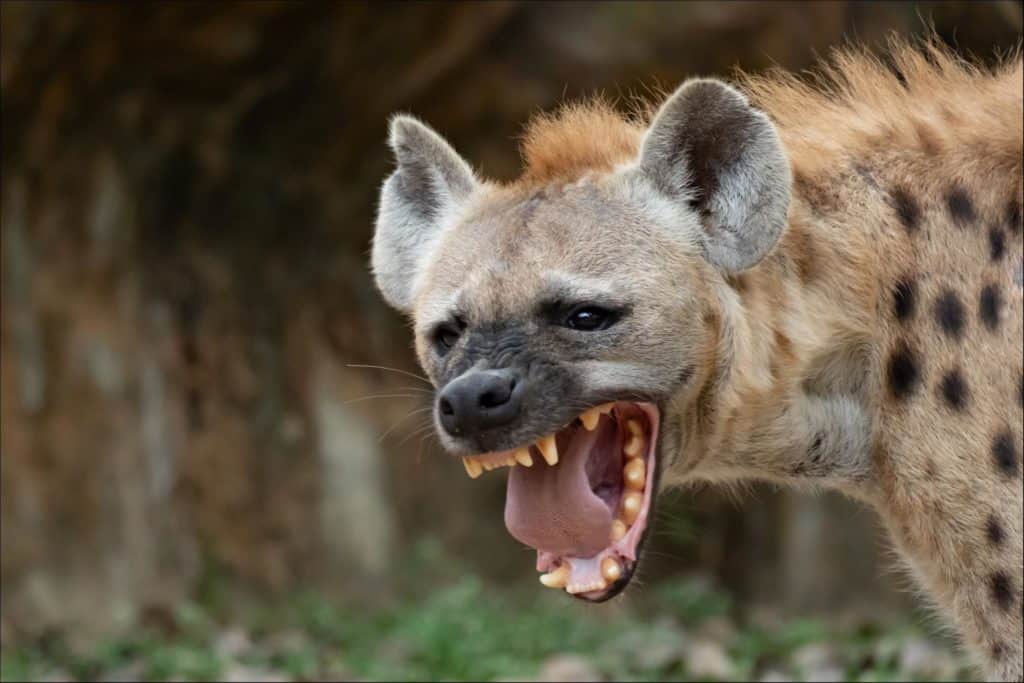
A hyena has twice the bite strength of a lion.
©J.NATAYO/Shutterstock.com
4. Martial Eagles
The martial eagle is one of the world’s deadliest avian predators. It is sometimes referred to as “the leopard of the air.” The largest of all the eagles, the martial eagle can weigh up to 14 pounds with an 8.5-foot wingspan.
Given its prodigious size, the martial eagle must eat often. This airborne carnivore can take down prey much larger than itself, including small antelopes, dik-diks, and other ungulates.
This bird will also prey on carnivores, such as mongooses, civets, aardwolves, foxes, and even jackals.
This fearless bird of prey will sometimes target African cats. While it normally preys on kittens, the martial eagle has been known to kill mature caracals and servals.
These aerial assassins have even been documented attacking mature leopards and lions, probably in attempts to separate them from their young so the cubs could be carried off.
Cheetah cubs are also targets for martial eagles. While these birds likely could not take down a mature cheetah, unattended cubs are especially vulnerable to these predators.

The Martial eagle is a fearless bird of prey that will sometimes target African cats.
©Theodore Mattas/Shutterstock.com
Cheetahs on the Lookout
As a predator, the cheetah enjoys a 40-50% success rate when hunting. By comparison, lions are successful less than 30% of the time. The cheetah’s small size gives it the speed and agility to catch its quarry at such an efficient rate. But, that same diminutive size also makes the cheetah vulnerable to other predators. These cats are constantly on the lookout.
Cubs are easily the most at-risk, but even mature cheetahs sometimes become the target of large predators. While it may not be a common occurrence, the danger is enough to keep these speedy cheetahs on the run.
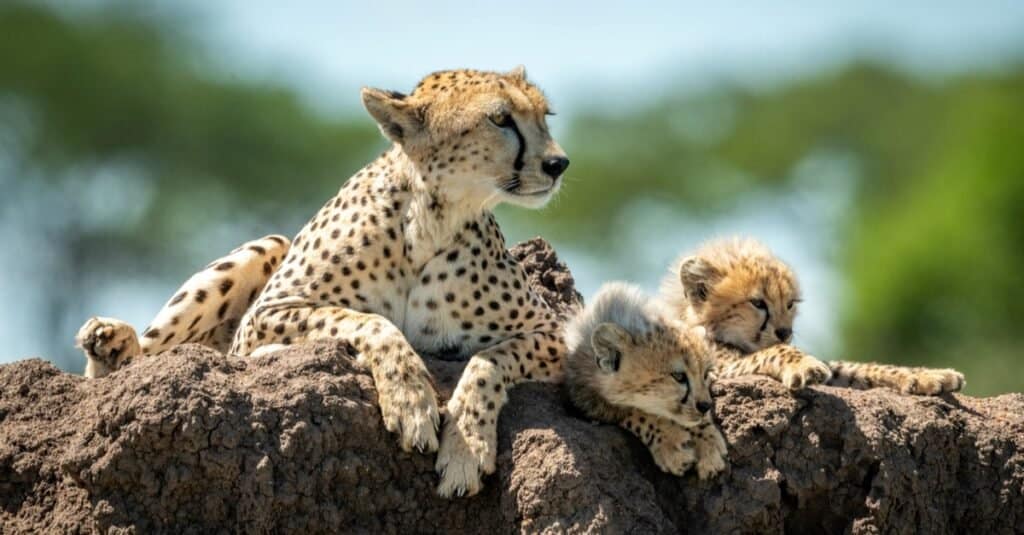
Cheetahs are constantly on the lookout to protect their cubs from predators.
©iStock.com/nicholas_dale
Summary of 4 Animals That Can Kill and Eat Cheetahs
| # | Animal | Strengths |
|---|---|---|
| 1 | Lions | Much larger animals and hunt in groups |
| 2 | Leopards | Incredible strength enables them to overpower prey |
| 3 | Hyenas | A bite force of 1,100 PSI and they hunt in groups |
| 4 | Martial Eagles | Huge birds of prey that can easily take cheetah cubs |
The photo featured at the top of this post is © iStock.com/slowmotiongli
Thank you for reading! Have some feedback for us? Contact the AZ Animals editorial team.




